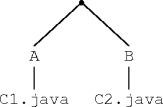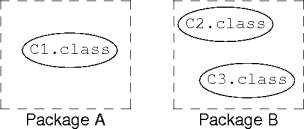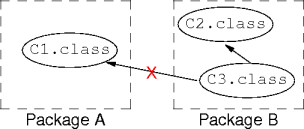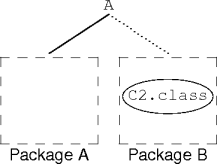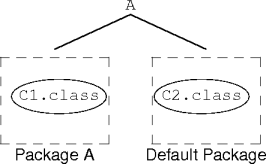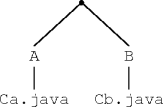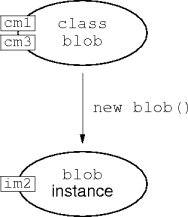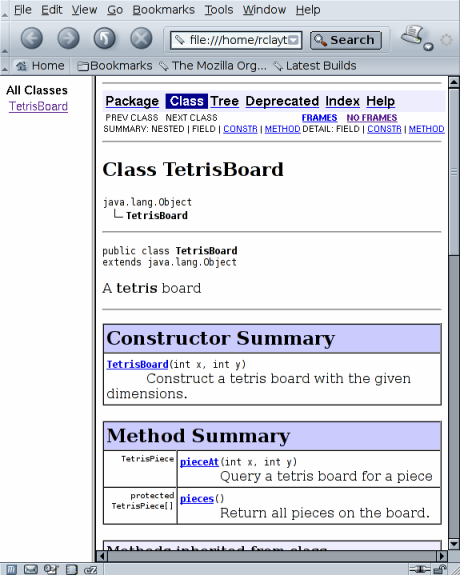Object-Oriented Programming with Java Lecture Notes
5 February 2009 • Classes, Part 2
Outline
- Scope
- Packages and class path.
- Comments and Javadoc.
Source Program Structure
- Java source comprises one or more source files.
- A source file is your basic text file.
- The filename should have a
.javaextension.
- Each source file contains one or more class definitions (among other things).
- Each class in a source file compiles in to a separate
.classfile.
Executable Structure
- The JVM builds an executable from
.classfiles.-
.classfiles are loaded at runtime as needed. - This is known as lazy link and load.
-
- This is an amazingly powerful and dangerous feature.
- Unfortunately, we won’t be pursuing it in this class.
Compilation
- The
javaccompiler also deals with.classfiles.- It needs them for type checking, for example.
- The compiler manages source-
.classfile consistency automatically.- Newer source files are compiled to update older (or nonexistent)
.classfiles.
- Newer source files are compiled to update older (or nonexistent)
Development Structure
- What kind of development structure works well with Java?
- The trick here is there are two set of files: the source and the
.classfiles. - But this is no different from the source-object (
.o) file distinction in C-C++.
- The trick here is there are two set of files: the source and the
- One possibility is a monolithic structure: all files in one place.
Monolithic Problems
- Monoliths are not well structured, and so don’t scale well and are difficult to deal with.
- Break monoliths up into interacting pieces.
- Functional division is usually the best, but there are other ways.
- The result is a set of mini-monoliths.
- But each new monolith is smaller and functionally consistent.
Packages
- A package is
a named group
of
.classfiles.- Every
.classfile is a member of exactly one package.
- Every
- A source file declares package membership with a
packagestatement:package package-name;
- Every
.classfile created from the source file belongs to the declared package.
- Every
Accessing Classes
- Given a class reference via its name
TetrisBoard board;
the compiler and JVM need access to the associated
.classfile.- Searching all packages could be expensive.
- There could be several classes with the same name in different packages.
Class Access
- You tell the compiler (and the JVM) the package holding the class.
- Package qualification indicates class package membership.
<package-name>.<class-name> board.TetrisBoard board;
- The TetrisBoard
.classfile in the board package.
- The TetrisBoard
- Almost every class reference has to be package qualified.
Scope
- Can a class access any other class in any other package?
- Scope refers to the extent over which a feature exists and can
be accessed.
- An existent and accessible feature is called in-scope.
- A non-existent or inaccessible feature is called out-of-scope.
Scopes So Far
- Packages, classes, and methods are the scopes seen so far.
- There are others to come.
- The features introduced so far are packages, classes, methods, and
field variables.
- There are others to come.
The General Questions
- Can feature X in scope Y be accessed from scope Z?
- If so, how?
- How can scope Z be prohibited from accessing feature X in
scope Y?
- This is an important question.
- The combinatorics of these questions are complex.
Package Scope and Classes
- By default, each class in package X can access any class in
package X.
- Accessed by using just the class name.
- Package qualification optional.
- The compiler defaults to searching the containing package for other classes.
- Accessed by using just the class name.
- By default, classes not in package X cannot access any class in package X.
- This is the default package scope.
Package Scope Example.
$ ls A B $ ls A C1.java $ ls B C2.java $
|
|
Package Scope Example..
|
|
Package Scope Example...
$ javac B/C2.java B/C2.java:8: A.C1 is not public in A; cannot be accessed from outside package A.C1 c1; ^ 1 error $
Package Scope Example....
|
|
Widening Package Scope
- Default package scope is too restrictive.
- Cross-package accesses are essential.
- The public scope for a class (or just public class) allows access to the class from any package.
- A public class starts with the
publickeyword.- Public scope is a per-class scope, not per-package.
Public Class Naming
- The name of the source file containing a public class must be the same
as the public-class name.
$ cat t.java public class T { } $ javac t.java t.java:1: class T is public, should be declared in a file named T.java public class T { } ^ 1 error $ - Only one public class per source file.
Public Scope Example.
$ ls A B $ ls A C1.java $ ls B C2.java $
|
|
Public Scope Example..
|
|
Public Scope Example...
$ javac B/C2.java $
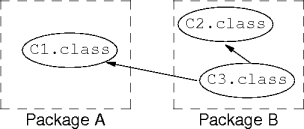
Observations
- A class has either public or package scope.
- All or nothing access is clumsy.
- Package scope is global within the package.
- Every class in the package can access every other class in the package.
- Problems with this suggest design errors.
- In particular, the package’s too big.
The Default Package
- Every
.classfile is a member of some package.$ cat A/C1.java class C1 { } $ -
packagestatements are optional. What package isC1in? - Classes not explicitly placed in a package fall into the nameless default package.
Abbreviating Package Qualification
- Every non-local class access has to be package qualified, which is a pain.
- The
importstatement explicitly locates a class.importpackage-qualified-class; - Imported classes don’t need package qualification.
- Identically named classes from different packages still need package qualification.
Import Example
|
|
Global Imports
- Import statements of the form
import every public class from the given package.importpackage.*; - There’s some documentation value to importing individual classes.
- With a good IDE it doesn’t much matter.
-
*imports could lead to unnecessary name clashes.
Mapping Packages
- What is a package in the real world?
- A package maps naturally to directory in a file system.
- Mapping to directories is not required, but is the most conventional and convenient.
- Package
tetrismaps to the directorytetris.- This mapping is most natural, but not required.
!! Warning !! Warning !!
- As the general semanticists remind: the map is not the territory.
- Do not confuse directories and packages.
- They are different but related things.
- In particular, not every class in a directory is part of the same package.
-
javacdoes not check to see that a source file in a package is being compiled in the proper directory for the package.
Package Mismapping Example
|
|
Package Mapping Example.
$ ls A $ ls A C1.java C2.java $ |
|
Package Mapping Example..
|
|
Package Mapping Example...
$ javac A/C2.java
A/C2.java:1: cannot find symbol
symbol : class C1
location: class C2
class C2 { C1 c1; }
^
1 error
$
- Even though they share the
Adirectory, both packages are separate.
Package Mapping Example....
- However,
$ cat A/C2.java class C2 { A.C1 c1; } $ javac -Xlint -classpath .. A/C2.java $ - This can’t be reversed: C1 can’t access C2.
- Only default package entities can access default package entities. Why?
Hierarchical Packages
- Packages nest to form a tree structure.
- Package levels are separated by a dot.
package tetris; package tetris.player.computer;
- Package levels are separated by a dot.
- Package hierarchies map naturally to file-system hierarchies.
- The package
tetris.player.computercorrespondstetris/player/computer(on Unixoid systems).
- The package
Imports and Nesting
- Import statements deal with
.classfiles, not nested packages.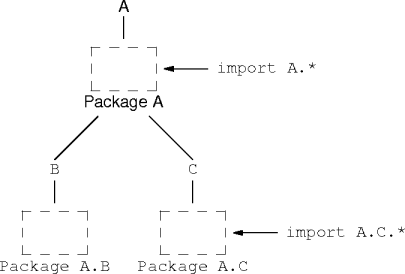
No Really, Where are the Packages?
- Knowing that package X is in directory X isn’t too helpful.
- Because where’s directory X?
- The classpath describes locations where package directories may
be found.
- It lists parent directories that may contain package directories.
The -classpath Option
-
javacandjavahave the-classpathcommand-line option (also-cpforjava) to set the classpath.- The default classpath is the current directory (
.). -
javacalways searches.;javaonly by default.
- The default classpath is the current directory (
- The classpath is a colon separated list of directories.
- On Unix; check for other systems.
Classpath Example.
|
|
Classpath Example..
$ javac Cb.java
Cb.java:1: package A does not exist
class Cb { A.Ca ca; }
^
1 error
$
- Huh? Why doesn’t package
Aexist?
Classpath Example...
- Classpath defaults to
. - The search for packages starts in directory
B. - Classpath needs to point to
B’s parent to findA.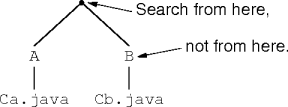
Classpath Example....
$ javac -classpath .. Cb.java $
- Whew.
The CLASSPATH Environment
- Typing “
-classpathblah” all the time is a pain.- Unless maybe if you use make or ant.
- You can set the
CLASSPATHenvironment variable instead.-
javacandjavause the contents ofCLASSPATHif-classpathisn’t given. - Don’t forget
.forjavaif you need it.
-
Cumulative Packages
- A package may appear in several class-path directories.
/usr/java: java.lang /usr/local/java: java.lang- The total package is the union of the individual packages.

Cumulative Package Search
- Class search is sequential through the class path until the class is
found.
- Then the search stops.
- This is a security problem.
/evil-doer/java: java.security.cert Certificate /usr/java: java.security.cert Certificate- But it's also a useful way to interpose code in an existing system.
Tracing Package Search
- The
-verbose:classJVM option produces output describing class loading.- It produces a lot of information.
- It writes to
std-outrather thanstd-err.
- Example
$ java -verbose:class fact [Loaded java.lang.Object from shared objects file] [ blah blah blah ] [Loaded java.math.BigInteger from shared objects file] [Loaded java.math.MutableBigInteger from shared objects file] 1! = 1 2! = 2 [ and so on ]
Method Scope
- Method scope is independent of class scope.
- By default, methods have package scope.
- Any class in the same package can access the method.
- Methods with public scope can be accessed from any class in any
package.
- Public-scope methods have the
publicmodifier.
- Public-scope methods have the
Method Scope Example.
$ cat A/Ca.java
package A;
public class Ca {
public void yes() { }
void no() { }
}
$ cat B/Cb.java
import A.Ca;
class Cb {
void blue() {
Ca ca = new Ca();
ca.yes();
ca.no();
}
}
$
Method Scope Example..
$ javac B/Cb.java
B/Cb.java:7: no() is not public in A.Ca;
cannot be accessed from outside package
ca.no();
^
1 error
$
Private Method Scope
- A method
mwith private scope can only be accessed by features in the same class asm.- Right now, the only sensible features are other methods.
- No access from other classes in the same package.
- Private-scope methods have the
privatemodifier.
Instance-Variable Scope
- An instance variable can have public, package, or private scope.
- By default, instance variables have package scope.
- This is a bad default; instance variables should almost always be private.
- Public or private scope is indicated by the
publicorprivatemodifier.
- By default, instance variables have package scope.
- Access rules are the same as for methods.
Class and Instance Methods
- By default, methods are called on class instances.
classInstance
.method(args...)- A method manipulates the instance’s state, among other things.
- If there’s no class instance, there’s no method.
- But what about constructors? Where’s the instance there?
Class Methods
- A constructor is an example of a class method, a method called
without reference to an instance.
- There’s no
thisinside a class method.
- There’s no
- A method becomes a class method by using the
staticmodifier.static double sin(double x) { ... } - Static and access are independent.
static public, static private
Class Method Access
- Class methods are accessed using the name of the containing class:
ClassName
.staticMethod(args...)- And package if necessary.
- Static imports let you drop the class-name prefix.
import staticclass.staticMethod;import staticclass.*;
Class vs. Instance Methods
- Class methods can directly access only other class methods.
- A class method can access instance methods via a class instance.
- Instance methods can directly access class methods.
- Going through the class name is fine too.
Method-Access Example
|
|
Java Programs
- Java programs (as opposed to applets) start executing in the
mainmethod of the formpublic static void main(String args[]) { ... } - Beware the sticky static problem.
- The
main()static spreads throughout the class. - Have a main class that does nothing but set-up and run the program.
- The
Example.
public class fact {
private BigInteger
fact(BigInteger i) {
// blah blah blah
}
public static void
main(String args[]) {
// blah blah blah
System.err.println(
i + "! = " + fact(i));
}
}
Example..
$ javac -Xlint fact.java
fact.java:29: non-static method
fact(java.math.BigInteger)
cannot be referenced from a static context
System.err.println(i + "! = " + fact(i));
^
1 error
$
Example...
public class fact {
private static BigInteger
fact(BigInteger i) {
// blah blah blah
}
public static void
main(String args[]) {
// blah blah blah
System.err.println(
i + "! = " + fact(i));
}
}
Class and Instance Variables
- As with methods, so with variables.
- A variable becomes a class variable by using the
staticmodifier.static public double pi = 3.1415;
- Static and scope are independent.
- Class variables should be private or immutable.
- Class and instance methods can access class variables independent of scope.
Comments
- Comments can either be single line or multi-line.
// Ignore to end of line. /* Ignore until next star-slash. */
- Multi-line comments do not nest.
- Javadoc comments are multi-line comments of the form
/** blah blah blah */
Javadoc
-
javadocis a JDK documentation tool.- It extracts javadoc comments from Java source and formats them as HTML pages.
|
|
|
Javadoc Comments
- Javadoc comments is text with HTML tags and
@-keywords.-
javadocparses@-keywords, passes along HTML. - Be careful mixing HTML and
@-keywords.
-
- A feature’s javadoc comment immediately precedes the feature.
- Javadoc can document packages, classes, methods, and variables.
Class Comments
- A class comment should immediately precede the related class.
- Useful
@-keywords for classes include@author,@version, and@deprecated.- Always document a deprecated feature's replacement.
- By default, only public classes are documented.
- Document them all, pick subsets with javadoc options.
Method Comments
- A method comment immediately precede the related method.
- Useful
@-keywords for methods include@param,@returns, and@throws.-
javadocperforms sanity checks on these keywords.
-
- By default, only public and protected methods are documented.
Field-Variable Comments
- A field-variable comment immediately precedes the related variable.
- By default, only public and protected variables are documented.
- Example
/** The card’s rank. @invariant 0 ≤ rank < 13 */ private int rank;
Other Comment Types
- Javadoc also provides package and overview (framework, subsystem) documentation.
- These comments require separate HTML files.
-
package.htmlandoverview.html
-
- File placement depends on directory structure.
-
package.htmlgoes in the package directory. -
overview.htmlgoes in some ancestor directory.
-
Running Javadoc
-
javadoc’s a complicated program, but simple invocations usually do. - Make sure you have a separate documentation directory.
-
javadocgenerates a lot of files. - Use the
-dcommand-line option, or runjavadocin the documentation directory.
-
Javadoc Quirks
-
javadocis a chatty program.-
javadocwarnings are useful but hard to see. - Use the
-quietcommand-line option to cut the chatter.
-
- By default,
javadocdocuments only public or protected features.- Use the
-privateor-packagecommand-line options to document more features.
- Use the
Javadoc Example
$ ls impl playerAPI $ javadoc -quiet impl playerAPI $ ls allclasses-frame.html impl overview-tree.html allclasses-noframe.html index-all.html package-list constant-values.html index.html playerAPI deprecated-list.html overview-frame.html resources help-doc.html overview-summary.html stylesheet.css $ rm -r *html *css resources package-list $ ls impl playerAPI $ javadoc -d doc -quiet impl playerAPI Creating destination directory: "doc/" $ ls doc impl playerAPI $ firefox doc/index.html
Generalizing Javadoc
- Doclet generalizes
javadoc.- Create new document components and document formats.
- The trick: generate documentation that’s Java code.
- Boilerplate-code generation.
- Used a lot in J2EE systems.
Summary
- Scope sets an entity’s extent and visibility.
-
public,package(default), andprivate. - Classes, methods, and field variables.
-
- Packages group related class files.
- Packages sort of map onto directories.
- The class-path maps onto packages.
- Javadoc is a cumbersome swiss-army knife.
